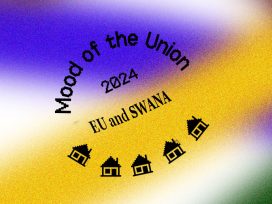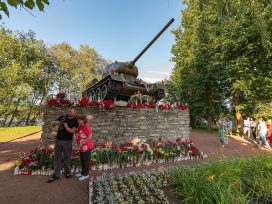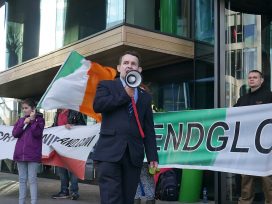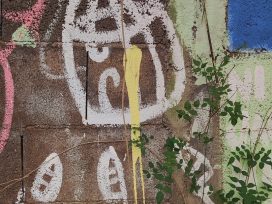The sudden collapse of the Assad regime on 8 December 2024, which put an end to the mukhabarat (secret police) state-dynasty that had ruled Syria for the past 54 years, was unforeseen by international observers and even surprised most Syrians. The war raging since 2012 had pitted the regime against various militias, including ISIS; fuelled by international sanctions, the result was a humanitarian and migration crisis. Now, in a matter of weeks, hope for a better future returned. Across the country and in the diaspora, Syrians rejoiced.
But neither celebration nor surprise have prevented quick action by the new Syrian authorities on the diplomatic front. Led by the former jihadist chief Ahmad al-Sharaa (nom de guerre, Abu Mohammad al-Julani), Hay’at Tahrir al-Sham (HTS) has embarked on a public relations campaign aimed at reassuring both regional and international actors about the direction the ‘new Syria’ will take. European leaders, for their part, have moved quickly to engage the de facto government, despite not lifting the terrorist designation on HTS. Officials of countries that had moved to normalize with Assad just weeks before his fall now travelled to meet those who had brought about his downfall.
The flurry of diplomacy is understandable. Al-Sharaa and his ministers seek recognition of their leadership, given HTS’s Al-Qaeda origins, and more importantly for the country, an end to the crippling sanctions imposed by the US and EU on the Assad regime. As al-Sharaa and his foreign minister Asaad al-Shaibani repeatedly insist, funds need to flow in order to revive a decimated economy.
But a certain mutuality characterizes the eagerness to kickstart positive relations post-Assad. European countries are interested in a stable and palatable Syrian regime, and particularly in the return of Syrian migrants and refugees. The influx of millions of Syrians since 2015 is seen by their increasingly unwelcoming host states to have caused enormous political disruptions, above all in the form of a resurgent far-right.
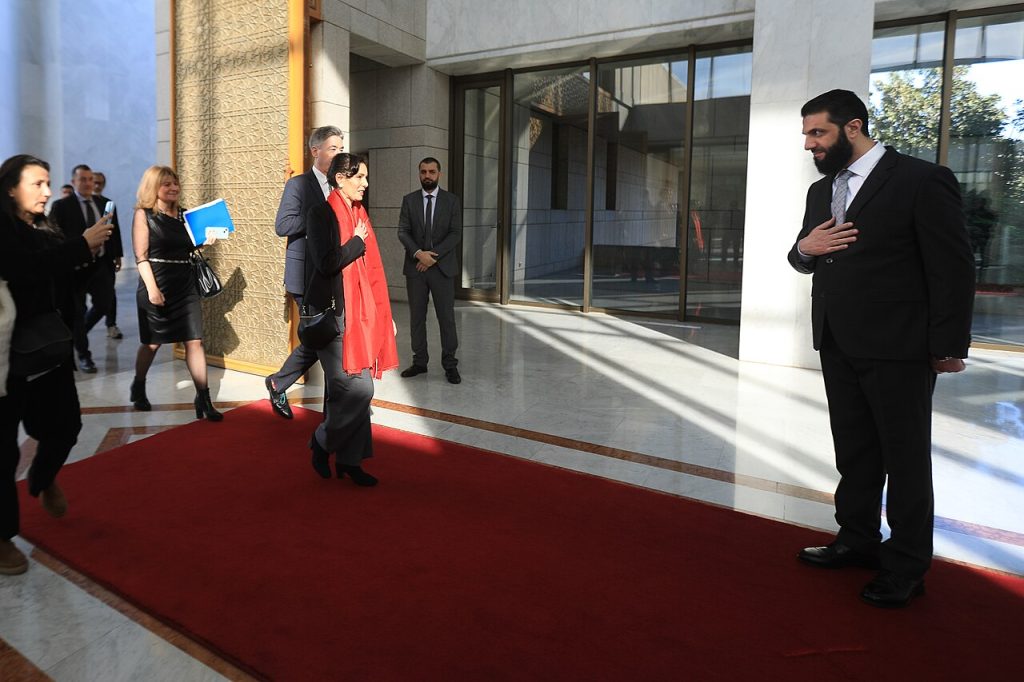
Ahmad al-Sharaa receives EU Commissioner Hadja Lahbib, 17 January 2025. Image: EC – Audiovisual Service / Source: Wikimedia Commons
Alongside traditional economic and security interests, European leaders’ engagement with the new Syrian leadership may also be motivated by the need to demonstrate political acumen in the Middle East. The utter failure of European diplomacy in Gaza is not yet behind us.
Diplomacy meets transition
In a highly fluid situation, diplomatic activity is not in itself indicative of the direction of political change in Syria. Tensions between the internal demands accompanying transition and the external pressures emanating from Europe and the US complicate matters immeasurably. In the first two months after Assad’s fall, a Turkey-backed al-Sharaa seemed to have been prioritizing foreign diplomacy over outreach to domestic and diasporic political actors. Regionally, his administration’s accomplishments so far include being embraced by the Gulf states, crowned by a February visit to the Kingdom. Saudi Arabia and Qatar have pledged financial support and have echoed Damascus’s plea to have sanctions lifted. Following the US lead, the EU recently announced a plan for a 12-month, partial suspension of sanctions, conditional upon the new government in Damascus meeting EU benchmarks on political inclusiveness and human rights.
But domestic politics has lagged behind. For weeks after Assad’s fall, Syrians were held in suspense about what would happen next. Finally, at the end of January, al-Sharaa was named president, formally kicking off the transition. The announcement came in a ‘victory conference’ of the now unified militias that – sans the Kurdish Syrian Democratic Forces – will become the National Army. The next day, al-Sharaa presented a brief roadmap. Addressing Syrians for the first time, he promised to appoint a ‘mini legislative council’ to put in place a provisional constitution. In a still vaguely outlined process, a new constitution will also be drafted and, eventually, elections held.
Civil society inputs and democratic demands are vital to shaping this long-awaited, Assad-free political future. After many weeks of waiting, a seven-person national dialogue committee was announced in February. After a series of town hall-style meeting across several Syrian cities, a National Dialogue Conference was held in Damascus on 25 February, culminating in 18 resolutions and the assurance of a detailed report documenting participants’ contributions. But without dismissing the opportunity the national dialogue offers, the process has so far been found wanting: there is no a clear calendar with a realistic timetable and deadlines, no collectively agreed rules and procedures, no far-reaching agenda, and no independent convenors.
In view of Europe’s well-oiled diplomatic relationships with non-democratic leaders in the region, not to mention the Gaza genocide, synchronized calls for ‘inclusion’ may not be taken at face value. But this does not alter the fact that a broad cross-section of Syrians clearly expect the broadening and deepening of political participation. The country’s revolution came at a high price. Fourteen years of popular struggle for freedom and dignity spiralled from peaceful protests into a complex, bloody war, with casualties in the hundreds of thousands and the displacement (internal and external) of half the population. Countless citizens in and outside Syria are counting on being participants and not just observers of the transition. Interpreting the dynamic political situation in Syria therefore requires attention both to diplomatic utterances as well as local (and diasporized) Syrian positions – and to the encounters between them.
Europeans converge on Damascus
The pictures and videos of European leaders streaming into Damascus to meet the former HTS leader Ahmad al-Sharaa have been among the more unexpected developments in the region’s turbulent politics over the past weeks. High-level officials include Annalena Baerbock and Jean-Noël Barrot, the foreign ministers of Germany and France respectively, who visited the country together in early January. They were preceded by the head of the EU Delegation to Syria, Michael Ohnmacht. The German diplomat was appointed in September 2024 with the mandate of dealing with a country formally still ruled by the Assad regime; in an ironic twist of fate, he now represents the EU in its relations with a post-Assad Syria.
There were cries of sexism in the western media when al-Sharaa refused to shake Baerbock’s hand. But the controversy was rebuffed by many Syrians, who viewed it as not quite respectful of religious and cultural traditions and protocols. Just a week later, Syrian foreign minister Asaad al-Shaibani readily shook Baerbock’s hand on the margins of the Davos meeting of the World Economic Forum.
The fixation on semiotic and cultural practices such as handshakes and clothing may seem trivial. However, the intense reactions on the Syrian (and broader Arab) side do not emerge from a vacuum. They reflect a sensitivity to western dealings with Arabo-Islamic societies produced by long histories of western colonialism followed by ongoing interventions in postcolonial states such as Syria. Orientalized discourses, whether in academia, media or politics, are all too familiar. In the current case, the substance of European leaders’ messaging often gives the impression of an eastern society that must be taught or reminded of civilized western standards.
Statements by official European visitors to Damascus point to two sets of issues. The first is the imperative of including women and minorities in the new systems and structures of governance. France’s foreign minister Barrot, for instance, said that he and Baerbock had ‘obtained assurances’ on the ‘broad participation – particularly of women – in the political transition’. The implication was that participation was a concession extracted from Sharaa. But in fact, the women and minorities issue was the headline of their joint meeting. Baerbock added a warning that EU funding would not be awarded to ‘Islamist structures’ in the country.
Possibly aware of the hubbub surrounding Baerbock’s and Barrot’s visit, Italy’s deputy foreign minister Antonio Tajani emphasized economic cooperation and a shared civilizational pedigree after meeting al-Sharaa and al-Shaibani. But he stayed on-message regarding inclusion. Like the French Foreign Minister, Tajani met with Christian communities, signalling a European interest in the age-old ‘minority question’ in the Arab East (al-mashriq al-‘arabi). The French have also confirmed ongoing support, alongside the Americans, for the Kurdish Syrian Democratic Forces (SDF) still hanging onto territory in the northeast. The Kurds ‘must find their place in this political transition’, the French Foreign Minister told his US counterpart Antony Blinken in January.
Of course, the SDF issue is a complicated one involving separatist aspirations, oil riches, and a global coalition fighting ISIS. About more than simply the ‘integration’ of SDF, it involves a history of political inequality, cultural repression, and socio-economic marginalization in state policies, as well some level of social discrimination. However, the ‘minority’ label is a common one in western treatment not just of Kurds (non-Arab Sunni Muslims), but also Christians, Alawites, Shiites, and so on. For most Syrians, the term ‘minorities’ carries overtones of colonial divide-and-rule. They tend to view the ‘minority’ ticket as a justification for the western pursuit of security-economic interests.
There is also frustration that European policy discourses often treat Syria (and other neighbouring countries) as a bundle of separate ethnic and religious identities mired in primordial conflicts, rather than as nations with long histories of coexistence. Some Syrian commentators have called for ditching all political references to religious, sectarian or ethnic origin in favour of the ‘citizenship’ of Syrians regardless of background. The new Syrian administration has preferred the term ‘components’ (al-mukawwinat) to ‘minorities’ (al-aqaliyyat), and al-Sharaa and al-Shaibani have even begun to sprinkle the term ‘citizens’ into their evolving political discourse.
Another example of the minority issue used by the West to further its security interests concerns the Israeli occupation of (more and more of) southern Syria, which like Israel’s destruction of most of Syria’s remaining military capabilities has gone unrebuffed by western allies. The Israeli prime minister’s recent remarks that Israel ‘will not tolerate any threat to the Druze community in southern Syria’ and that Israel will not allow Syrian forces ‘south of Damascus’ have drawn the ire of Syrians, who have called for protests against Israel.
A second feature of European discourses on Syria have been blanket instructions for Russia’s departure. In the days after Assad’s night flight, the EU High Representative Kaja Kallas insisted that the closure of Russia’s bases be an agenda item for the EU’s diplomacy in Damascus. She also drew a lesson from Assad’s fall: ‘Russia is not invincible’. Baerbock was also unequivocal: ‘it is time for Russia to leave its military base in Syria’, she intoned upon leaving Damascus. What Syrians object to in such statements is the continuation of regional and international meddling. The US has prioritized its fight against ISIS as its airstrikes continue. European leaders, too, still project their security interests onto Syria, now in a time of peace-building rather than war-making.
None of this is to say that Syrians see Russia in a positive light. On the contrary, Russia’s ‘scorched earth’ bombing of cities like Aleppo made Syrians fear the skies. Russia’s military intervention largely rescued the regime from collapse as it fought off numerous rebel factions, and Bashar al-Assad himself stealthily escaped to Moscow on 8 December. Nevertheless, al-Sharaa’s administration, likely in tandem with Turkey, has not yet settled the question of Russia’s presence. While there are unconfirmed reports that the Syrian authorities have cancelled port management contracts with Russia, Damascus is reportedly still in talks with Russia about whether it will depart from their airbase in Hmeimeim. Whatever agreement is reached, the point is that international pressures remain abundant even after control of the country has changed hands – and that these are a source of tensions.
‘Revolutionary’ civil society?
Syrian social media, television media appearances and published political commentary has been in overdrive since 8 December. A tradition of civic engagement, which appeared tentatively during the Damascus Spring in the early 2000s before roaring into life after the 2011 revolution, has now been fully revitalized. Reactions of pride and astonishment at the rapid-fire diplomatic achievements of al-Sharaa and al-Shaibani are widespread across ideological tendencies. But while patterns are still difficult to measure in any systematic sense, the positions of some segments of organized civil society are very clear.
The insistence on inclusivity has been expressed not just verbally but through various meetings between Syrian civil society leaders, including women activists, and European diplomats, including the EU Commissioner for Equality, Preparedness and Crisis Management Hadja Lahbib. This interpenetration of international, local and diasporized actors and discourses in Syria’s ever-shifting politics further confirm the centrality of civil society since Assad’s departure. To understand the political transition in Syria today, one therefore needs to look beyond western interactions with al-Sharaa and his administration and focus on the role of civil society in the 14 years between the Syrian Revolution and the overthrow of the Assad dynasty.
In a largely Muslim country such as Syria, where local traditions and forms of agency reflect indigenous histories and ‘modernities’, civil society does not always meet the standards prescribed by Euro-American understandings of the concept. The ‘autonomy’ carved out militarily by HTS in Syria’s Northern Idlib in the last four years of the Assad regime was, arguably, antithetical to that propounded in western theories of civil society. Factors generally considered to be integral to civil society-driven change – e.g. peaceful protest, public disobedience, or ‘colour’ revolution – were absent in the events leading up to 8 December. The civil society groups approximating or cooperating with western counterparts were tangential at best to the brand of religious and armed ‘civility’ directly responsible for the collapse of the regime.
How, then, to understand the concurrence, such as it is, between the dispositions and directions of Syria’s civil society and those of the EU after the ouster of Assad? Here the local hirak – or popular mobilization – comes into focus. While not contributing militarily to the collapse of the Assad regime, a wide-ranging Syrian hirak has been active over the past 14 years of revolution, with groups playing numerous roles and taking various organizational forms.
Hirak in transition
Syria’s multi-pronged civil society includes political bodies formed in the early months of the 2011 revolution. Yet none of them – be it the Syrian National Council, the National Coalition of Syrian Revolutionary and Opposition Forces (Etilaf), or the High Negotiating Committee (HNC) – succeeded in asserting themselves after the fall of Assad; they have now either recognised al-Sharaa’s presidency or fallen by the wayside. According to the declaration issued at the end of the HTS ‘Victory Conference’, revolutionary bodies and revolutionary civil society will be dissolved.
There will be little regret at the dissolution of Etilaf and the HNC, which have long been deemed elitist and politically ineffective. But the local councils of opposition-held areas are viewed more positively by many. From Daraya near Damascus to Syria’s north, they were significant centres of civic organization and in some cases, democratic governance. If local administration is restructured, as is planned in connection with the new constitution, these too may end up belonging to the revolutionary past, even allowing for some kind of decentralization in the northeast or Suwayda in the south.
The prospect of the thousands of Syrian civil society organizations painfully built during the revolution being swallowed up or prevented from working gives many pause. Some CSOs are in the process of registering with the new authorities, but the precise contours of the state’s openness to civil society are still being determined.
Humanitarian work (including that carried out by religiously oriented groups) was a necessity borne of war. Here civil society stepped in to provide education, medical assistance, psychological support, orphanages, and a range of other needs for local populations that ordinarily the state would provide or at least administer. International donors, both individual, organizational and even governmental, have been key here. Some of these groups will likely continue operating in a country where the poverty rate is still 90% and medical infrastructure has either been destroyed by war or is sorely out of date. The recent arrival of a Saudi medical mission reflected the paucity of care and shortage of qualified personnel in the country. The return of thousands of Syrian doctors from exile may cause a crisis for Germany and other European countries, but their services will be welcome in Syria so long as there is funding.
While these humanitarian organizations may not be expected to issue declarations regarding the new powers in Damascus, some have. The Syrian Civil Defence Forces or White Helmets of international renown have taken an active role in working with the new authorities to rescue people from prison, clean up cities, and the like. In a recent podcast interview, Raed Saleh, the director of the White Helmets, averred that he would be willing to ‘hand over the keys’ of his organization to a democratically elected government, and perhaps return happily to his hometown.
Civil society also includes religious bodies, the most prominent of which is the Syrian Islamic Council formed in 2014. Made up of imams from inside and outside Syria, it oversees a range of religious and proselytizing (da‘wah) activities, and issues regular statements on political developments. As a kind of religious authority with a sizable following or ‘base’, it acts as a source of support and guidance for religious Sunni Syrians opposed to Assad both in the country and outside it. From the beginning of Rad‘ al-Udwan operations, the Islamic Council published statements and made television appearances backing the offensive. They prominently congratulated al-Sharaa when he was named interim president.
Such backing is notable given the Council’s public differences with HTS in the recent past. Upon his return to Damascus, the head of the Council Shaykh Usama al-Rifa‘i, named Mufti of the Syrian Republic from his Istanbul diaspora in 2021, has had high-profile encounters with al-Sharaa, including at the funeral of his brother (also a Shaykh) Sariyah al-Rifai. It is not yet clear what the future of the Syrian Islamic Council’s official relationship with the new authorities will be. One major question is whether it will replace or somehow be folded into the Religious Endowments (Awqaf) Ministry that, in the fashion of all Arab countries, is the state arm overseeing religious activities.
At the other end of the spectrum of Syrian civil society are organizations whose specific focus is human rights, transitional justice and democracy. A number of these groups – including Baytna, The Day After, Badael and Madaniya – have strong connections to western and international funding agencies. Both Madaniya’s philanthropist donor and executive director met al-Sharaa early after he took power in Damascus and afterwards were cautiously optimistic about the meeting. As the well-known Aljumhuriya news and culture website put it, there is a ‘reluctant’ determination among many Syrian civil society actors to engage the new powers. The only alternative is opting out of the whole transition, an approach antithetical to democratic, participatory aspirations.
Transitional justice, for example, is a sticky issue in Syria: the scale of crimes committed by Assad, his allies, and some of the anti-Assad military factions is so enormous as to have affected nearly every family in Syria in some way. Many of the families of the victims of Assad’s prisons, whether departed or still missing, hold sit-ins in Marjah Square in central Damascus, demanding information and accountability. Pictures of their loved ones adorn a monument in the Square. This is part of the daunting process of transitional justice in Syria that will surely take years.
One indication of the potential for cooperation and openness between these groups and the (former) HTS leaders was the First Syrian Conference for Transitional Justice held in Damascus at the end of January, reportedly attended by an advisor to the Justice Minister. A series of recommendations to the interim government, published at the close of the event, included the immediate issuing of a temporary constitutional decree; clear communication with the public; regular meetings with civil society and citizen stakeholders; a prohibition on justice personnel guilty of human rights violations; protection of information and evidence for future trials; and, most importantly, ‘building a relationship of transparency and cooperation between civil society and state institutions’, thus providing the space for civil society to operate and benefit the country with its experiences.
Another of the Transitional Justice Conference recommendations for both the state and civil society was the inclusion of women in relevant transitional justice and political work. Gender inclusion and equality are not the ‘discovery’ of civil society upon hearing statements by western officials. Rather, a host of organizations have consistently and systematically addressed women’s economic and civic-political empowerment over the past fourteen years. Some are religiously oriented, others are more overtly secular in their platforms and demands and clearly influenced by international norms and policies, including the UN Women, Peace, and Security Agenda. The Syrian Women’s Political Movement memorably held its first conference from Damascus in January 2025, some of its members meeting with visiting western officials.
While there is something of a cultural divide (secular vs. religious, westernized vs. locally oriented) in Syrian women’s activism, akin to that found in most other Arab-Muslim countries, it is not necessarily ironclad. The discourses of many groups and individuals are changing. That may be one reason why an early interview by Ayesha Al-Debes, the new authorities’ appointee as Head of the Women’s Office, provoked such controversy. Her comments about a ‘new model’ for Syrian women, pointed discussion of women’s maternal and family role, negative remarks about foreign-funded, ‘self-styled’ feminist women’s groups, and her suggestion that she would not listen to those with whom she disagreed, spurred debate among Syrians across the political-ideological spectrum for days. On top of the challenge of expanding the breadth of civic space, women’s society groups face the conundrum of how to engage one another in civil, and civically productive fashion.
Looking ahead
For the foreseeable future, Syria’s new leaders will face the tasks of persuading regional and international world leaders to ease sanctions, of rebuilding a rock-bottom economy, and of manage the steady influx of returnees. They will need to do this while seeking to maintain order and security in a territory that is not yet fully under their control. On the European side, leaders who for years have more-or-less boycotted the Syrian state and dealt almost exclusively with civil society groups will have to shift gear and direct diplomatic attention to the new (interim) state officials, while keeping up meetings with civil society groups.
Syrian civil society, too, is in flux. Formal and informal organizations of ‘revolutionary civil society’ are, after all, comprised of ordinary citizens eager to restart and rebuild their lives in what is being called the Third Republic. Some are returning home, although others are unable to do so or proceeding with more trepidation. Even if the foremost issue on Syrians’ minds is livelihoods and living arrangements, civic and political concerns are alive and well. Expressions and appraisals of all manner of public statements and decisions prompt passionate exchanges online and off.
The uncertainty of the moment is combined with the scent of possibility, something sensed not just by Syrians, but by Europeans too. A democratic Syria is not yet won. But with the demise of Assad, it is closer now than ever before. European officials should take note that just as Syrians made their own revolution, so they should lead the way into their own post-Assad future.
